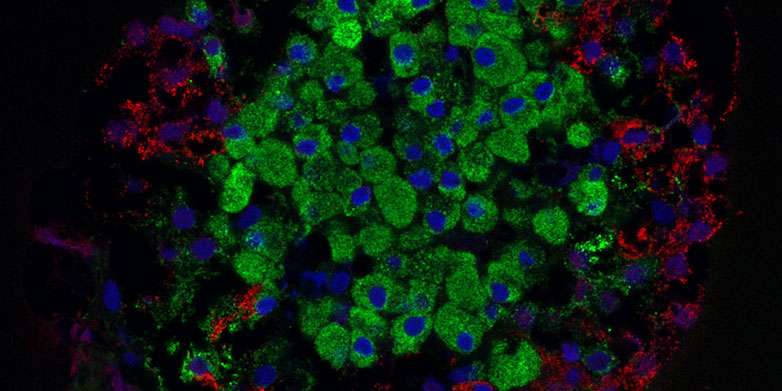New diabetes targets could allow protection of pancreatic beta cells

A central feature of type 1 diabetes is loss of the pancreatic beta cells that make insulin. Researchers led by Paolo Fiorina, MD, Ph.D., of Boston Children's Hospital and Francesca D'Addio, MD, of the University of Milan now identify a harmful cellular pathway that causes these cells to die. When they blocked the pathway in mice and in human islets, where beta cells reside, they preserved beta cells, increased insulin production, and prevented or delayed the onset of diabetes.
The study, published February 3rd in Nature Communications, used three different mouse models of diabetes, and found protective effects whether the pathway was blocked genetically or with an antibody. Studies of human cells and people with diabetes were consistent with the mouse findings. The researchers hope to develop a therapeutic to block the pathway to treat type 1 diabetes.
The pathway, they showed, consists of a "death receptor" on insulin-producing beta cells called TMEM219, coupled with insulin-like growth factor binding protein 3 (IGFBP3), which interacts with this receptor. When IGFBP3 binds to TMEM219, the researchers found, beta cells die through the process of apoptosis.
"We believe this might be a natural mechanism to keep the beta cell population under control," says Fiorina. "We think that in disease, IGFBP3 production may be increased, so there is a loss of beta cells."
Supporting this idea, the team studied different groups of people with diabetes and found increased levels of IGFBP3 circulating in their blood as compared with nondiabetics. Levels were also increased in people at risk for developing diabetes and in diabetic and prediabetic mice.
Keeping beta cells alive
In the mice, the researchers used several means to block the IGFBP3/TMEM219 pathway: blocking IGFBP3, deleting the TMEM219 receptor gene, or using a recombinant protein based on part of TMEM219. Each approach preserved the beta cells, increased insulin production, and delayed or prevented diabetes. When the team blocked the pathway for a longer period of time, populations of beta cells expanded.
Fiorina and colleagues also studied human pancreatic islets, in which the beta cells reside. When they exposed the cells to IGFBP3, they had a higher rate of death by apoptosis. When they blocked the IGFBP3/TMEM219 pathway, beta cells were protected and continued making insulin.
"The common thought for type 1 diabetes is that it autoimmune," says Fiorina. "But immunotherapy doesn't completely cure diabetes. We think that dysregulation of beta cell homeostasis also plays a role and that IGFBP3 acts as a 'betatoxin.'"
Fiorina founded a biotechnology company in Italy called Enthera in 2016 that is developing biologics based on these discoveries. First-in-human tests of an antibody treatment to block the IGFBP3/TMEM219 pathway could begin as early as September 2022 in Europe.
More information: Nature Communications (2022). DOI: 10.1038/s41467-022-28360-2

















